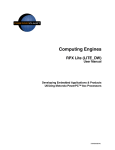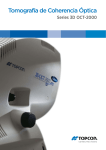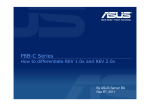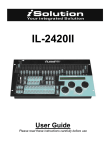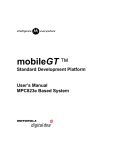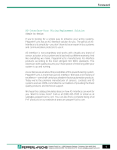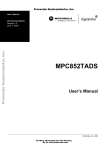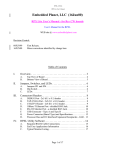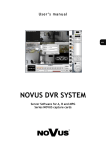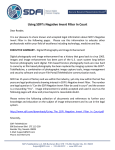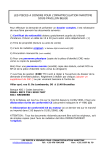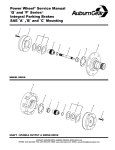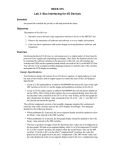Download H Card (HIOX_BW), User Manual
Transcript
I/O Expansion H Card (HIOX_BW) User Manual Developing Embedded Applications & Products Utilizing Motorola PowerPC™ 8xx Processors 700M0010RA0 2 700M0010RA0 I/O Expansion, H Card Notice This manual in whole or in part, is to be considered the intellectual property of Embedded Planet. The manual and all information explained and derived there from are protected by the license to which you agreed upon opening this package. This document contains confidential information and is intended for the sole purpose of the end user to develop applications on the H Card product offered by Embedded Planet, LLC. Neither the document, nor reproductions of it, nor information derived from it is to be given to others, nor used for any other purpose other than for H Card applications. No use is to be made of it which is or may be injurious to Embedded Planet, LLC and no use is to be made of it other than for H Card applications. Trademarks Embedded Planet, PlanetTrack, Linux Planet, Blue Planet, RPX Lite, and RPX LICC are trademarks or registered trademarks of Embedded Planet. PowerPC is a trademark of International Business Machines. All other names and trademarks are the property of their respective owners. 700M0010RA0 3 I/O Expansion, H Card 4 700M0010RA0 I/O Expansion, H Card Contents Chapter 1 Introduction .......................................................................................................... 7 Functions .........................................................................................................................................7 Mix and Match Criteria and Exclusions .....................................................................................7 850/823 Based Product ..........................................................................................................7 860/821 Based Product ........................................................................................................10 Miscellaneous Restriction ....................................................................................................10 Video .......................................................................................................................................10 LCD .........................................................................................................................................11 Matrix ......................................................................................................................................11 How to Use This Manual ............................................................................................................11 Reference Documents ..................................................................................................................11 Chapter 2 Setup ................................................................................................................... 13 Strapping .......................................................................................................................................13 Chapter 3 Connectors and Headers ................................................................................... 15 JTAG Interface Header ................................................................................................................15 Flat Panel Interface Headers .......................................................................................................15 LCD Power Supply Header ........................................................................................................17 SCC3, SCC1, or SMC1 RS-232 Port ............................................................................................17 SMC2 RS-232 Port ........................................................................................................................18 SCC2 RS-232 Port .........................................................................................................................18 SCC2 IrDA Port ............................................................................................................................19 S-Video Port ..................................................................................................................................19 Composite Video Jack ..................................................................................................................19 Line Out Stereo Audio Jack ........................................................................................................19 Line In Stereo Audio Jack ...........................................................................................................20 Touch Panel Interface Header ....................................................................................................20 Bus and I/O Interface Expansion Connectors .........................................................................21 List of Figures No. 1-1. 1-2. 700M0010RA0 Title Page H Card Board - Top View ................................................................................................8 H Card Board - Bottom View ..........................................................................................9 5 I/O Expansion, H Card List of Tables No. 1-1. 1-2. 2-1. 3-1. 3-2. 3-3. 3-4. 3-5. 3-6. 3-7. 3-8. 3-9. 3-10. 3-11. 3-12. 3-13. 6 Title Page Hardware Features ...........................................................................................................7 Reference Documents.....................................................................................................11 Strapping..........................................................................................................................13 JTAG Header Pinout (P10) ............................................................................................15 Flat Panel Header Pinout (P8A) - NEC........................................................................16 Flat Panel Header Pinout (P8B) - SHARP ...................................................................16 LCD Power Supply Header Pinout (P8C)...................................................................17 SCC3, SCC1, or SMC1 RS-232 Header Pinout (P4) ....................................................17 SMC2 RS-232 Header Pinout (P3) ................................................................................18 SCC2 RS-232 Header Pinout - (P5) ...............................................................................18 SCC2 IrDA Port Pinout (P6) ..........................................................................................19 S-Video Port Pinout (P7)................................................................................................19 Stereo Output Jack (P12)................................................................................................20 Stereo Input Jack (P11) ...................................................................................................20 Microtouch Touch Interface Pinout (P9) .....................................................................20 Dynapro Touch Interface Pinout (P9) ..........................................................................20 700M0010RA0 Introduction Chapter 1 The H Card (HIOX_BW) is an I/O expansion daughter card designed for the Embedded Planet CPU boards (MPC8xx SBC). The H Card is designed to allow the user to gain access to additional features and functions of the MPC8xx family, along with supporting additional peripheral functions not able to be placed on the CPU boards (due to space limitations). The H Card is in a PC104 board form factor and has the same board mechanical outline as does the RPXL, LITE, and CLLF products. It plugs directly onto the CPU boards via the bus expansion and I/O expansion plugs (pinouts are listed in the pinouts file associated with the CPU board). Functions The functions included on the H Card are listed in Table 1-1. For programming information, refer to the H Card Programmer’s Firmware Manual. Table 1-1. Hardware Features Entity Video Function Video (PAL and NTSC) via a composite video signal output on a BNC or SMT connector Video on an s-video connector LCD Flat panel interface header RS-232 SMC2 (no handshake) RS-232 SCC3 or SCC1(handshake) SMC1 (no handshake) IrDA (infrared) SCC2 (1.0/1.1) RS-232 SCC2 (handshake) Audio Stereo line out and line in (with microphone interface) Touch screen 1 BCSR Passive touch screen interface Control and status register NOTE: 1. Refer to the H Card Programmer’s Firmware Manual for a description of the BCSR register. Mix and Match Criteria and Exclusions 850/823 Based Product 700M0010RA0 • LCD and Video are available on the 823. They are not available on the 850. • SMC2 RS-232 is mutually exclusive with audio. Only one of these peripheral functions can be enabled at any given time. 7 Chapter 1 - Introduction I/O Expansion, H Card AUDIO IN AUDIO OUT IN OUT TOUCH PANEL INTERFACE YP YXN W P9 1 XYN XP P8C NEC GND 5 + 1 LCD POWER 1 P12 P11 – P8A FLAT PANEL INTERFACE 1 2 850 860 P8B JP1 1 30 31 P5 SHARP 1 SCC2 JS1 P4 COMPOSITE VIDEO P10 RS-232 1 SCC1/3 1 JTAG P6 P7 P3 1 SMC2 JTAG IrDA (INFRARED) S-VIDEO T00022A Figure 1-1. H Card Board - Top View 8 • SCC2 is used for three peripheral functions: Ethernet, RS-232, and IrDA. Only one of these peripheral functions can be enabled at any given time. Ethernet is on the CPU card, where as RS-232 and IrDA are on the H Card. • SCC3 is only available on certain versions of the MPC850/823 processor family. • SCC1 is not available. USB is supported in place of SCC1. • If SMC1 is enabled on the H Card, it must be disabled on the CPU board, and vice-versa. 700M0010RA0 I/O Expansion, H Card Chapter 1 - Introduction ROA4 ROB4 P2 ROB5 P1 ROA5 RO2 RO1 B1 A1 B1 ROB3 A1 ROA3 T00023A Figure 1-2. H Card Board - Bottom View • SMC1 on the H Card can support soft control of the handshake signals (RTS# and CTS#) and soft control of the modem control signals (DTR#, DSR#, and RI#). • If SCC3 is available, SCC3 CD# is mutually exclusive with audio. If audio is enabled, SCC3 CD# signal is not available for use on port C. SCC3 CD3# is available for status in a BCSR all the time. • The P4 RS-232 serial port connector is used for either SMC1 or SCC3. Only SMC1 or SCC3 can be enabled at P4 at any given time. • Five possible configurations can be implemented, with all functions running simultaneously, as follows: USB, SCC2, SCC3, SMC1 on the CPU board, SMC2, and LCD or Video. USB, SCC2, SCC3, SMC2, TOUCH, and LCD or Video. 700M0010RA0 9 I/O Expansion, H Card USB, SCC2, SCC3, AUDIO, TOUCH, and LCD or Video. USB, SCC2, SMC1 on either board, AUDIO, TOUCH, and LCD or Video. USB, SCC2, SMC1 on either board, SMC2, TOUCH, and LCD or Video. NOTE: SCC2 can be Ethernet, IrDA, or RS-232. 860/821 Based Product • LCD is available on the 821. LCD is not available on the 860. • SCC2 is used for two peripheral functions: RS-232 and IrDA. Only one of these peripheral functions can be enabled at any given time. • SCC3 is not available on the 821. SCC3 is only available on certain versions of the MPC860 processor family. • SCC1 is used for two peripheral functions: Ethernet and RS-232. Only one of these peripheral functions can be enabled at any given time. Ethernet is on the CPU board, where as RS-232 is on the H Card. • If SMC1 is enabled on the H Card, it must be disabled on the CPU board, and vice-versa. • SMC1 on the H Card can support soft control of the handshake signals (RTS# and CTS#) and soft control of the modem control signals (DTR#, DSR#, and RI#). • The P4 RS-232 serial port connector is used for either SMC1, SCC1, or SCC3. Only one of these ports can be enabled at P4 at any given time. • Three possible configurations can be implemented, with all functions running simultaneously, as follows: ETH, SCC2, SCC3, SMC1 on the CPU board, SMC2, AUDIO, TOUCH, and LCD. ETH, SCC2, SMC1 on the H Card, SMC2, AUDIO, TOUCH, and LCD. RS-232, SCC2, SMC1 on the CPU board, SMC2, AUDIO, TOUCH, and LCD. NOTE: SCC2 can be IrDA or RS-232. Miscellaneous Restriction The RPXC (860/821 based board) supports RS-232 via SCC2 directly on the board. If SCC2 is used on the H Card, and the H Card is used with the RPXC, SCC2 RS-232 on the RPXC must be disabled via the BCSR. This restriction does not apply to the CLLF (860/821 based board). Video Video is only applicable to CPU boards based on the MPC823 (RPX Lite). When video is supported, the video encoder (ADV7176A) requires a VDOCLK (27 MHZ) clock source. This clock source can be supplied by the MPC823, provided that the internal frequency of the processor is running at a multiple of the 27 MHZ, or the clock source can be supplied by the external on-board 27 MHZ oscillator. Port D pin PD3 is used for the Video Encoder clock signal. 10 700M0010RA0 I/O Expansion, H Card Chapter 1 - Introduction When the VDOCLK is supplied by the MPC823, PD3 must be configured as an output and the ENVDOCLK control signal (BCSR0 bit-6) must be disabled (logic 0). The VDOCLK drives both the video controller in the MPC823 and the Video Encoder on the H Card. The MPC823 must be running at an internal frequency that is a multiple of 27 MHZ (54 MHZ, 81 MHZ, etc.) This will not be the recommended or preferred method, since obtaining these exact frequencies requires custom oscillator frequencies driving the processor. When the clock is supplied by the external (onboard) 27 MHZ oscillator, PD3 must be configured as an input and used as the clocking signal for the Video Controller inside the MPC823. The ENVDOCLK control signal (BCSR0 bit-6) must be enabled (logic 1), for the oscillator to drive both the PD3 pin and the Video Encoder. LCD LCD is only applicable to CPU boards based on the MPC823 (RPX Lite). When LCD is supported, the MPC823 LCD Controller generates an LCDCLK out signal on PD3. Therefore, the ENVDOCLK control signal (BCSR0 bit-6) must be disabled when driving LCD panels. Matrix For detailed information on the various hardware configurations, the drivers that need to be loaded for each configuration, and the port I/O pins that are assigned to which function, refer to the expansion connector port usage document (hiox_po.pdf). How to Use This Manual 1. Refer to Chapter 2 for setup information including strappings. 2. Refer to Chapter 3 for a description of the connectors and headers available on the HIOX board. Reference Documents Table 1-2 lists additional Embedded Planet documents for the H Card board. Table 1-2. Reference Documents Document Number 700M0010RA0 Description 700M0002R__ PlanetCore, Diagnostics and Utilities (Release 1) 700M0011R__ H Card Programmer’s Firmware Manual 11 I/O Expansion, H Card 12 700M0010RA0 Setup Chapter 2 This chapter describes the various strappings that setup the HIOX_BW board for operation. The straps are zero ohm, surface-mount resistors. Strapping Table 2-1 describes the various strap settings; refer to Figures 1-1 and 1-2 for the locations of the straps. Table 2-1. Strapping Purpose CPLD SCAN signal Strap RO1 Function Populated = CPLD SCAN signal is connected to pin 30 of the NEC Hirosi connector (standard configuration as shipped). Not populated = CPLD SCAN signal is not connected to pin 30 of the NEC Hirosi connector. Microphone (MIC_IN) SMC1 Touch controller RO2 Populated = microphone has the audio signal on the end. Not populated = microphone has the audio signal on the tip (standard configuration as shipped). ROA3 RS-232 transceiver drives the DTR# true all the time (5 VDC minimum at 1.67mA). ROB3 5 VDC rail drives the DTR# signal all the time (for powering IR keyboards). ROA4 Populated for Microtouch touch panels. ROB4 ROA5 Populated for Dynapro touch panels. ROB5 700M0010RA0 13 I/O Expansion, H Card 14 700M0010RA0 Connectors and Headers Chapter 3 The HIOX_BW board contains: • • • • • • • • • • One JTAG interface header. One flat panel interface (i.e., LCD) header. One LCD power header. Three RS-232 ports. One IrDA port (eight-pin, mini-DIN). One s-video port (four-pin, mini-DIN). One composite video jack (BNC or SMC). 3.5 mm line in/line out stereo audio jacks. One touch panel interface header. Two daughter card expansion plugs: bus and I/O. This chapter describes these connectors and headers. Refer to Figures 1-1 and 1-2 for the locations of these connectors and headers. Refer to the PlanetCore Diagnostics and Utilities for information about the PlanetCore utilities available for testing the HIOX board. JTAG Interface Header The JTAG header (P10) is a 2 × 5 (0.1 × 0.1) header. There is only a single device in the JTAG chain on the board, the CPLD device. This header is used for programming and verifying the contents of the CPLD device. Table 3-1 shows the JTAG header pinout. Table 3-1. JTAG Header Pinout (P10) Pin Function Pin Function 10 GND 9 TCK 8 GND 7 TMS 6 +3.3V 5 TDO 4 GND 3 TDI 2 GND 1 TRST# NOTE: Pin numbering 1 through 10 as shown in the table is when looking down onto the header. Flat Panel Interface Headers The flat panel headers (P8A and P8B) are 2 × 20 (0.1 × 0.1) headers. The headers are pinned either for NEC/MIT connection (P8A) or SHARP connection (P8B). Silkcreening on the PCB identifies the headers by the letters NEC and SHARP. Tables 3-2 and 3-3 show the flat panel header pinouts. 700M0010RA0 15 Chapter 3 - Connectors and Headers I/O Expansion, H Card Table 3-2. Flat Panel Header Pinout (P8A) - NEC Pin Function Pin Function 1 GND 2 (PD3) LCDCLK 3 (PD4) HSYNC# 4 (PD5) VSYNC# 5 GND 6 R0 7 R1 8 (PB31) LCD_A = R2 9 (PD9) LD2 = R3 10 (P8) 11 (PD7) LD7 = R5 12 GND 13 G0 14 G1 15 (PB19) LCD_B = G2 16 (PD12) LD5 = G3 17 (PD11) LD4 = G4 18 (PD10) LD3 = G5 LD1 = R4 19 GND 20 B0 21 B1 22 (PB17) LCD_C = B2 23 (PD15) LD8 = B3 24 (PD14) LD7 = B4 25 (PD13) LD6 = B5 26 GND 27 (PD6) BLANK# 28 +5.0V 29 +5.0V 30 No connect or SCAN2 31 SCAN NOTE: 1. Pin numbering 1 through 31as shown in table is when looking down onto the header. 2. Pin 30 connection set by RO1. Table 3-3. Flat Panel Header Pinout (P8B) - SHARP Pin 16 Function 2 Pin Function 1 For +10V or V+ 2 +5.0V 3 +5.0V 4 GND 5 SCAN 6 (PD13) LD6 = B5 7 (PD14) LD7 = R5 8 (PD15) LD8 = B3 9 (PB17) LCD_C = B2 10 B1 11 B0 12 GND 13 (PD10) LD3 = G5 14 (PD11) LD4 = G4 15 (PD12) LD5 = G3 16 (PB19) LCD_B = G2 17 G1 18 G0 19 GND 20 (P7) LD0 = R5 21 (P8) LD1 = R4 22 (PD9) LD2 = R3 23 (PB31) LCD_A = R2 24 R1 25 R0 26 For -10V or V-2 27 (PD5) VSYNC# 28 (PD4) HSYNC# 29 GND 30 (PD3) LCDCLK 700M0010RA0 I/O Expansion, H Card Chapter 3 - Connectors and Headers Table 3-3. Flat Panel Header Pinout (P8B) - SHARP (continued) Pin Function 31 GND Pin Function NOTES: 1. Pin numbering 1 through 31 as shown in table is when looking down onto the header. 2. The +10V and -10V power rails can be any voltage as required by the LCD panel. The are available on P8C, as shown in Table 3-4. LCD Power Supply Header The LCD power supply header (P8C) provides a convenient means of connecting power to LCD panels. Table 3-4 shows the LCD power supply header pinout. Table 3-4. LCD Power Supply Header Pinout (P8C) Pin Function 1 2 3 GND +5.0V V+ 4 5 V- NOTE: Pin numbering 1 through 5 is from top to bottom when looking down onto the board. SCC3, SCC1, or SMC1 RS-232 Port The SCC3, SCC1, or SMC1 RS-232 port (P4) is a 2 × 5 (0.1 × 0.1) header. Table 3-5 shows the RS-232 header pinout. The signals listed in the table are surge protected, with the transient voltage suppressors connected to EARTH GROUND. Table 3-5. SCC3, SCC1, or SMC1 RS-232 Header Pinout (P4) DB9 (DTE) Pin Function DB9 (DTE) Pin Function 1 1 CD# 6 2 DSR# 2 3 RXD 7 4 RTS# 3 5 TXD 8 6 CTS# 4 7 DTR# 9 8 RI# 5 9 GND 10 NOTES: 1. Pin numbering 1 through 10 as shown in the table is when looking down onto the header. 2. DTR#, DSR#, and RI# (modem control signals and yellow in table) are supported in the BCSR (soft support). 3. RI# (modem control signal and yellow in table) is supported on PC14. 4. RTS# and CTS# are not hard supported by SMC1, but can be soft supported via the port pins. The RS-232 port, when connected to SCC3 or SCC1, supports the (hardware controlled) handshaking signals of the respective SCC, and also supports the (software controlled) additional modem control signals via the BCSR. The RS-232 port, when connected to SMC1, can soft support both the handshaking and the modem control signals (no hardware handshake signal support like on SCC1 or SCC3). The pinout of the header is chosen such that a direct ribbon cable connection to the standard DB9 connector is possible (DB9 male wired as DTE). 700M0010RA0 17 Chapter 3 - Connectors and Headers I/O Expansion, H Card SMC2 RS-232 Port The SMC2 RS-232 port (P3) is a 2 × 5 (0.1 × 0.1) header. Table 3-6 shows the RS-232 header pinout. The signals listed in the table below are surge protected, with the transient voltage suppressors connected to EARTH GROUND. Table 3-6. SMC2 RS-232 Header Pinout (P3) DB9 (DTE) Pin Function 1 2 3 4 5 1 3 5 7 9 RXD TXD DTR# GND DB9 (DTE) Pin 6 7 8 9 2 4 6 8 10 Function RTS# NOTES: 1. Pin numbering 1 through 10 as shown in the table is when looking down onto the header. 2. RTS# not used (not driven by SMC2) and is tied true on board (driven true all the time on pin 4). 3. CTS# not used on board (not received by SMC2). 4. DTR# not used (not driven by BCSR) and is tied true on board (can be driven true all the time on pin 7 either by the transceiver or by the system 5 VDC supply). The RS-232 header is from SMC2, and as such, only supports a three-wire interface (no handshaking or modem support). The pinout of the header is chosen such that a direct ribbon cable connection to the standard DB9 connector is possible (DB9 male wired as DTE). SCC2 RS-232 Port The SCC2 RS-232 port (P5) is a 2 × 5 (0.1 × 0.1) header. Table 3-7 shows the RS-232 header pinout. The signals listed in the table are surge protected, with the transient voltage suppressors connected to EARTH GROUND. Table 3-7. SCC2 RS-232 Header Pinout - (P5) DB9 (DTE) Pin Function DB9 (DTE) Pin Function 1 2 1 CD# 6 2 DSR# 3 RXD 7 4 RTS# 3 5 TXD 8 6 CTS# 4 7 DTR# 9 8 RI# 5 9 GND 10 NOTES: 1. Pin numbering 1 through 10 as shown in table is when looking down onto the header. 2. DTR#, DSR#, and RI# (modem control signals and yellow in table) are supported in the BCSR (soft support). 3. RI# (modem control signal and yellow in table) is supported on PC12. The RS-232 header supports the (hardware controlled) handshaking signals of SCC2, and also supports the (software controlled) additional modem control signals via the BCSR. The pinout of the header is chosen such that a direct ribbon 18 700M0010RA0 I/O Expansion, H Card Chapter 3 - Connectors and Headers cable connection to the standard DB9 connector is possible (DB9 male wired as DTE). SCC2 IrDA Port The SCC2 IrDA port (P6) is an eight-pin, mini-DIN connector for dongle interface. Table 3-8 shows the IrDA port pinout. The IrDA dongle interface is shielded and tied to EARTH GROUND. Table 3-8. SCC2 IrDA Port Pinout (P6) 8 - ID3 7 - ID2 6 - ID1 5 - ID0 4 - +5V 3 - GND 2 - RXD 1 - TXD NOTES: 1. Pin numbering 1 through 8 as shown in the table is when looking into the front of the mini-DIN. 2. The blanks in the table represent the spacing between pins. S-Video Port The s-video port (P7) is a four-pin, mini-DIN connector located next to the bottom-right mounting hole. Table 3-9 shows the s-video port pinout. The s-video is shielded and tied to EARTH GROUND. Table 3-9. S-Video Port Pinout (P7) Pin Function 3 2 CHROMA LUMA 4 1 GND GND Pin Function NOTE: Pin numbering 1 through 4 as shown in the table is when looking into the front of the connector. Composite Video Jack The video composite jack (JB1 or JS1) is located near the bottom-right of the PCB. The center tap of the jack is the composite signal, and the outer shell of the jack is connected to digital ground. Line Out Stereo Audio Jack The line out or speaker jack (P12) is located at the back of the PCB. The speaker jack is wired for stereo operation (Table 3-10). The tip of the mating plug is for the left speaker, and uses Codec Channel 0. The center tap of the mating plug is for the right speaker, and uses Codec Channel 1. The section of the mating plug closest to the housing is ground. 700M0010RA0 19 I/O Expansion, H Card Table 3-10. Stereo Output Jack (P12) Plug Position Function 1 (tip) 2 (center tap) 3 Left speaker (channel 0) Right speaker (channel 1) GND Line In Stereo Audio Jack The line in or microphone jack (P11) is located at the back of the PCB between the line out or speaker jack and the terminal block. The microphone jack is wired for stereo operation (Table 3-11). The tip of the mating plug is for the left microphone, and uses Codec Channel 0. The center tap of the mating plug is for the right microphone, and uses Codec Channel 1. The section of the mating plug closest to the housing is ground. Table 3-11. Stereo Input Jack (P11) Plug Position Function 1 (tip) 2 (center tap) 3 Left microphone (channel 0) Right microphone (channel 1) GND Touch Panel Interface Header The touch interface header (P9) is used for the touch screen interface. Table 3-12 shows the header pinout for the Microtouch touch panels (ROA4 and ROB4 populated). Table 3-13 shows the header pinout assignment for the Dynapro touch panels (ROA5 and ROB5 populated). Table 3-12. Microtouch Touch Interface Pinout (P9) Pin Function 1 2 3 4 5 Y+ X- Y- X+ WIPER NOTES: 1. Pin numbering 1 through 5 shown in the table is from left to right when looking down onto the board. 2. WIPER is not used on four-wire interfaces. Only used for five-wire interface. Table 3-13. Dynapro Touch Interface Pinout (P9) Pin Function 1 2 3 4 5 Y+ Y- X- X+ WIPER NOTES: 1. Pin numbering 1 through 5 shown in the table is from left to right when looking down onto the board. 2. WIPER is not used on four-wire interfaces. Only used for five-wire interface. 20 700M0010RA0 I/O Expansion, H Card Chapter 3 - Connectors and Headers Bus and I/O Interface Expansion Connectors The processor bus expansion plug is the connector strip on the left side identified as P1. The processor I/O expansion plug is the connector strip on the right side identified as P2. They are 2 × 60 (B8 Type) plugs. The plugs pick up all the appropriate signals from the CPU board’s expansion receptacles to implement the functions listed in Table 1-1. Refer to the H Card Programmer’s Firmware Manual for pinout assignments. The standard plug used is AMP 179031-5, which provides for a board-to-board mating height of 16 mm. 700M0010RA0 21 I/O Expansion, H Card 22 700M0010RA0 I/O Expansion, H Card 23 700M0010RA0 I/O Expansion, H Card Embedded Planet 749 Miner Rd. Cleveland, Ohio 44143 www.embeddedplanet.com Form 700M0010RA0 Litho in U.S.A. Oct2000 Copyright © 2000 Embedded Planet, LLC. All Rights Reserved. Phone: 440.646.0077 Fax: 440.461.4329 Toll-Free: 877.468.6899

























